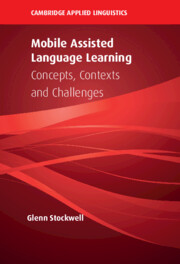Book contents
- Mobile Assisted Language Learning
- The Cambridge Applied Linguistics Series
- Mobile Assisted Language Learning
- Copyright page
- Dedication
- Contents
- Figures
- Tables
- Acknowledgements
- Abbreviations
- 1 Introduction
- 2 Fundamental Considerations of Teaching with Mobile Technologies
- 3 Shifting Paradigms in Language Learning and Teaching
- 4 Research Considerations in MALL
- 5 Theory in MALL
- 6 Physical, Psychosocial and Pedagogical Issues
- 7 The Learner in MALL
- 8 Designing MALL Environments
- 9 Concepts, Contexts and Challenges in MALL
- Glossary
- References
- Index
3 - Shifting Paradigms in Language Learning and Teaching
Published online by Cambridge University Press: 23 December 2021
- Mobile Assisted Language Learning
- The Cambridge Applied Linguistics Series
- Mobile Assisted Language Learning
- Copyright page
- Dedication
- Contents
- Figures
- Tables
- Acknowledgements
- Abbreviations
- 1 Introduction
- 2 Fundamental Considerations of Teaching with Mobile Technologies
- 3 Shifting Paradigms in Language Learning and Teaching
- 4 Research Considerations in MALL
- 5 Theory in MALL
- 6 Physical, Psychosocial and Pedagogical Issues
- 7 The Learner in MALL
- 8 Designing MALL Environments
- 9 Concepts, Contexts and Challenges in MALL
- Glossary
- References
- Index
Summary
The main focus of this chapter is to discuss how dramatically teaching and learning are changing, largely as a result of developments in technology. These changes have brought about changes in the roles of the teachers, of learners and even of the technologies themselves. Teachers not only have to manage their teaching environments, but they also need to manage their technological skills and the emotional load that goes along with the pressures of maintaining digital literacy. Learners are faced with having greater expectations to use technology, while it is expected that they are already skilled in using technologies for learning purposes. It explores the possible future directions of education, where teachers and learners need to consider not only what information needs to be learned, but also what information is acceptable to be referenced, along with the need to develop skills in evaluating information from the enormous amount of available resources. It also explores the view of teaching and learning in formal and informal contexts and looks at how mobile technologies have impacted both of these learning situations.
Keywords
- Type
- Chapter
- Information
- Mobile Assisted Language LearningConcepts, Contexts and Challenges, pp. 45 - 65Publisher: Cambridge University PressPrint publication year: 2022
- 1
- Cited by



